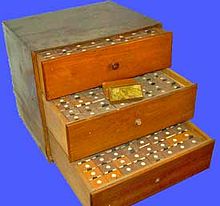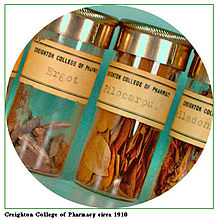- Crude medicine
-
Crude medicine (simplified Chinese: 药材; traditional Chinese: 藥材; pinyin: yàocái), (also known as crude drug in the Chinese materia medica) are bulk drugs from the Chinese materia medica basic processing and treatment.
Contents
Overview
 1916 Eli Lilly crude drug case for pharmacy students to study: contains 216 different specimens
1916 Eli Lilly crude drug case for pharmacy students to study: contains 216 different specimens
A crude drug[1] is any naturally occurring, unrefined substance derived from organic or inorganic sources such as plant, animal, bacteria, organs or whole organisms intended for use in the diagnosis, cure, mitigation, treatment, or prevention of disease in man or other animals.
Crude drugs[2] are unrefined medications in their raw or natural forms. Prior to the 1950s, every pharmacy student learned about crude drugs in pharmacognosy class. Pharmacognosy is the study of the proper horticulture, harvesting and uses of the raw medications found in nature.
Raising, harvesting and selling crude drugs was how many large pharmaceutical companies started out. Companies such as Eli Lilly and Company[3] sold crude drugs to pharmacists to save them time and money, but the early pharmacy graduate would know how to raise their own crude drugs if need be.
History
In times past, the hunter-gatherer community kept knowledge about the medicinal properties of various plants, molds, fungi, yeasts, bacteria, minerals and animals. This drug knowledge would include vast amounts of information like what time of the year to look for specimens, where to look, and what part of the plant to use or how to grind a mineral.
As cultures developed in specialization, a person would take on the combined role of physician, pharmacist and priest or minister. These specialized people would be in charge of the community’s physical, mental, emotional and spiritual health.
In English these are often called "medicine men" or shaman. The word shaman comes from Manchu, and is "the only commonly used English word that is a loan from this language".[4] The shaman would use various items from nature to produce a mixture that would be burned, applied, manipulated or ingested in some fashion to help relieve the symptoms the ailing patient.
Eventually, the use of crude drugs reach a zenith in the early 1900s and eventually gave way to the use of purified active ingredients from the natural source. Currently the use and exploration of crude drugs has again gained prominence in the medical community. The realization that many completely unknown substances are yet to be discovered from crude drugs has created a new interest in pharmacognosy and has led to many medical breakthroughs.
In 1907, the Pure Food and Drug Act was implemented and standardization of crude drugs took place. Often the USP would specify what percentage of active ingredient was needed to claim a crude drug met USP standards.
An example of standardization would be as follows (from the United States Pharmacopeia)[5]:
Opium is the air-dried milky exudate obtained by incising the unripe capsules of Papaver somniferum Linne or its variety album De Candolle (Fam. Papaveraceae). Opium in its normal air-dried condition yields not less than 9.5 percent of anhydrous morphine.
References
See also
Categories:
Wikimedia Foundation. 2010.

